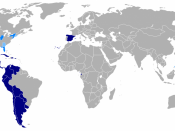Women in Hispanic society
Hispanic is a term created by the U.S. federal government in the early 1970s in an attempt to provide a common denominator to a large, but diverse, population with connection to the Spanish language or culture from a Spanish-speaking country. The term Latino is increasingly gaining acceptance among Hispanics, and the term reflects the origin of the population in Latin America.
Traditionally, the Hispanic family is a close-knit group and the most important social unit. The Hispanic family unit includes not only parents and children but also extended family. In most Hispanic families, the father is the head of the family, and the mother is responsible for the home. Individuals within a family have a moral responsibility to aid other members of the family experiencing financial problems, unemployment, poor health conditions, and other life issues.
Family ties are very strong: when someone travels to another town or city to study or for a short visit (e.g.,
vacation, business, medical reasons), staying with relatives or even with friends of relatives is a common practice. Families often gather together to celebrate holidays, birthdays, baptisms, first communions, graduations, and weddings. Hispanic families instill in their children the importance of honor, good manners, and respect for authority and the elderly. Preserving the Spanish language within the family is a common practice in most Hispanic homes.
A firm handshake is a common practice between people as greeting and for leave-taking. A hug and a light kiss on a cheek are also common greeting practices between women, and men and women who are close friends or family. The Spanish language provides forms of formal and nonformal address. In nonformal settings, conversations between Spanish speakers are usually loud, fast, and adorned with animated gestures and body language to better convey points.
Hispanics usually...


